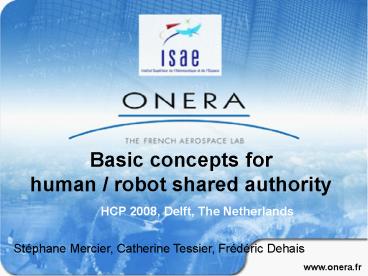Basic concepts for human robot shared authority - PowerPoint PPT Presentation
1 / 22
Title:
Basic concepts for human robot shared authority
Description:
human / robot shared authority. St phane Mercier, Catherine Tessier, Fr d ric Dehais ... A mission operated in the physical world by several agents, including ... – PowerPoint PPT presentation
Number of Views:100
Avg rating:3.0/5.0
Title: Basic concepts for human robot shared authority
1
Basic concepts for human / robot shared
authority
HCP 2008, Delft, The Netherlands
Stéphane Mercier, Catherine Tessier, Frédéric
Dehais
www.onera.fr
2
Outline
- Context, State of the Art and Objectives
- Three Main Functions
- Towards a First Formalization
- Experimental Setup
- Conclusion
3
Context
- A mission operated in the physical world by
several agents, including one or several humans - An Authority Sharing problem, with its
dynamicity - between artificial agents (automatic pilot, UAVs,
robots...) - between artificial agents and human operators
- Example of missions
- Monitoring
- Observations
- Search and Rescue
4
Authority Sharing example
- Mission Fire fighting
- A fireman supervising a robot
- To detect fires
- To extinguish starting fires
Buildings
?
5
State of the Art
- Adjustable autonomy
- Autonomy a relationship between entities about
an object Castelfranchi 2003 - Autonomy ability of the agent to reduce the need
of operator supervision Goodrich 2001 - Automation levels Sheridan 1978
- Autonomy measure Huang 2005
6
State of the Art
- Conclusion
- Autonomy levels are unsatisfying predefined, not
operational or mission specific - Human operator always considered as a perfect
solution, whereas she/he is fallible - Need of a formal basis for authority sharing who
does what, based on which objective criteria?
7
Objectives
- Why, when and how should an agent take the
initiative? - When the environment has changed?
- When an agent violates established procedures
(in particular the human operator)? - When an unexpected event occurs?
8
Relationship with the human Operator
- The operator
- Black box intentions unknown
- Information from observation
- But from the agents point of view
- Some operators abilities are known
- Task Model
- Interaction on the agents request
- To accomplish a Task (delegation)
- Validation / Veto
9
Three Main Functions
- From the agents side
- An Adaptive Autonomy structure based on three
core functions - Planning
- Situation Assessment
- Authority Sharing
10
Planning
- The planning function
- Allocates and Schedules tasks between entities in
order to reach mission objectives - Updates parts or totality of the global plan if
needed (replanning) in case of disruptive events
Possibility to optimize chosen criteria (e.g.
performance, operators time, etc.)
11
Situation Assessment
- The Situation Assessment function
- Constantly analyses the current state of the
system - Predicts the future states of the system
- Detects inconsistencies between predicted states
and observed states (conflicts)
Example a tasks failure
12
Authority Sharing
- The Authority Sharing function
- Identifies conflicts detected by the situation
assessment function - Solves conflicts if necessary with the planning
function
Several abstract solving methods available which
one to choose?
13
Basic concepts
- Mission basic concepts
- Resources (including tasks)
- Sources of resources
- Conflict
14
Resources
- An essential concept of the formalization
- Resources
- represent all items needed for the mission
accomplishment - are defined over time.
- Examples of resources
- Use of physical objects (sensor, fuel, etc.)
- Use of immaterial objects (pieces of information,
logical conditions, etc.) - Tasks
15
Resources tasks
- Tasks themselves are resources.
- A complex task can be divided into subtasks,
which are resources.
Example of a task instanciation nav1 lt
navigating, task, map, navAlgo, waypointList,
src gt
16
Source
- A source defines the producing entity of a
resource. - source lt tprod , e gt
- with tprod the production time
- and e the producing entity.
- There are several possible entities
- operator
- agent
- external world
- procedures
17
Conflict
- Informal definition
- an observed or predicted inconsistency
- disturbing the predicted execution of the plan
- occuring at the ressource level.
18
Conflict
Agents plan
- Example
r1
r2
r3
R3
- Task failure
- Operators action
Task1
Failing
r4
r5
Task2
19
Conflict
20
Conflict Solving
- Initiative decision of solving the conflict
- Solving Method
- Depends on the involved entities
- Temporary or definitive
- A consistent plan
- Examples
- tasks reallocation
- interaction
21
Experimental Setup
- GPS
- Odometry
- Inertial sensors
- Ultrasounds sensors
- Scenic camera
- Procosa
22
Conclusion
- Resources to model an agents plan
- Detection and identification of conflicts at the
resource level - Conflict solving
- Authority Sharing ? Conflit Detection Solving
- A work in progress
- Formalization to develop (Petri nets)
- Interface design
- Experimentations































